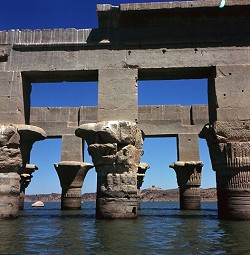
The annual inundation of the Nile was the result of the summer monsoon in Ethiopia and in Southern Sudan. Towards the end of May, the Nile at Aswan began to rise slowly, then swell strongly, and reach its highest point at the beginning of September. The waters began to recede in October, and the lowest point was again reached in May. The same cycle began near Cairo about two weeks later. In Egypt's dry climate, the inundation was a matter of life and death because the water was needed for irrigating the agricultural land. It was also important that the level of the inundation be neither too low nor too high; if the water stood for too long or too short a time on the fields, the harvest would fail and famine ensue. Furthermore, a water level that was too high would carry the risk of disease due to the many animals that would drown and whose corpses would contaminate the water. In addition, many buildings would be damaged by the water. It is hardly surprising that the inundation of the Nile played an important role in the religious life of the ancient Egyptians. The waters of the inundation were worshipped and feared as the divine power Hapy, who, personified, was depicted as a man with female breasts and a pot belly, with a bunch of papyrus plants on his head. Although on the one hand the source of the Nile was considered to be the 1st cataract, it was also connected with the primeval waters of Nun or with the Duat, and the water which streamed out was regarded as charged with regenerative power. This explains why Nile water could be associated with Osiris's bodily fluids, in which there was potential life. The king was responsible for the annual return of the inundation, and personally led the procession in the ritual which was to bring about this return.